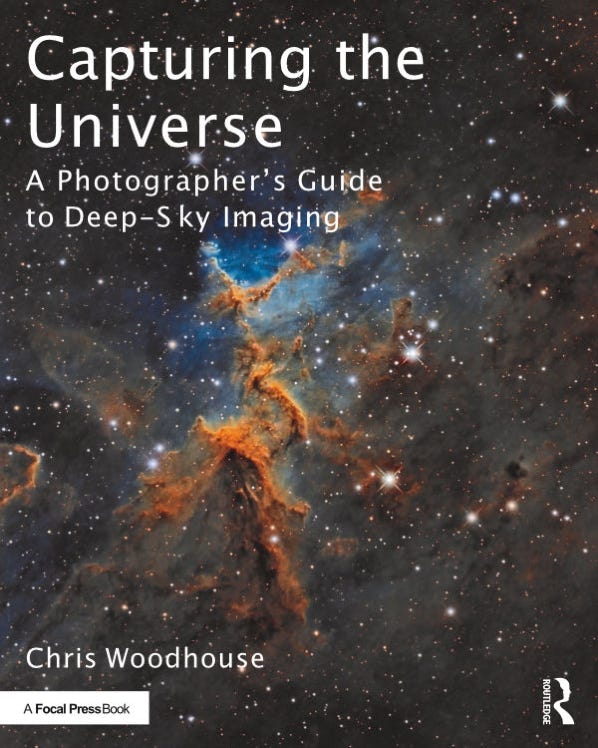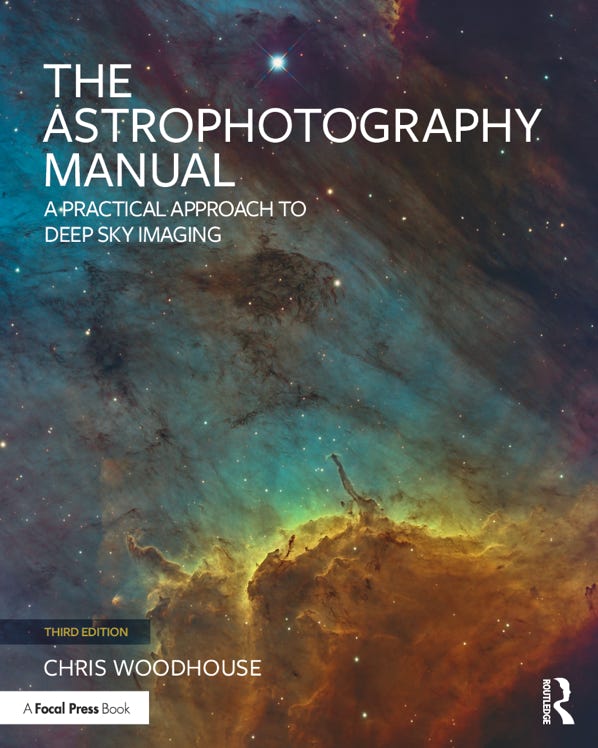Publications
In addition to my prior books on monochrome photography I have two astrophotography publications: The Astrophotography Manual and Capturing the Universe.. Both these books are available as e-books and in printed forms. I prefer the printed versions, with full-color glossy pages in an 8x10-inch format. With both titles I have strived to get a balance of information, science, practical advice, gorgeous images and a little self-deprecating humor. Astrophotography is a technical subject and I have learned from a lot of mistakes (and those of others) to reach this point! Available from all good bookstores, Amazon and direct from Routledge too.
There are numerous online reviews. Many rate The Astrophotography Manual as the best book ever written on the subject.


Capturing the Universe
Direct link to Routledge
ISBN: 978-0-367-36653-7 - paperback
After two years of experimentation, imaging and research, I submitted the final draft of Capturing the Universe. This book is aimed at those who want to try their hand at astrophotography. It starts off simple and progressively explains the techniques of deep-sky astrophotography, starting with nothing more than the reader’s own photographic equipment. I abandoned my observatory and had to start over with lesser means. Ironically, although I kept things simple, this book was the most difficult to write.
This is a hugely practical book, which explains the science only when it is required. The journey starts, using available equipment and progresses with simple tracking mounts, digital photographic cameras, moves on to dual-axis mounts, computer control and finally, uses dedicated CMOS astro cameras. Along the way it explains the techniques that are used to overcome the challenges that accompany imaging a moving, distant object that is so dim, it is a wonder that a sensor registers anything at all.
Since publishing The Astrophotography Manual, reliable CMOS astro cameras have become more widely available. Capturing the Universe looks at them in detail and how to get the best from them, including imaging with color versions. One of the practical projects constructs an electronic camera release which can be operated through a shared ASCOM driver, allowing many DSLR and mirrorless cameras to be used in computerized setups.
This book tries to keep to a budget and makes best use of free or inexpensive software for image acquisition and processing and makes full use of the standard photo-editors, such as Adobe Photoshop and especially Affinity Photo, which is a bargain.
In essence, this book is for current digital photographers who wish to take up astrophotography. Its 240 pages are filled with 290 color illustrations.
The Astrophotography Manual (Third Edition)
Direct link to Routledge
ISBN: 9781003463108 - paperback
After the success of the first two editions, the third edition of The Astrophotography Manual is a completely re-written and revised follow-up. This picks up on the very latest technology (both hardware and software) and, like its predecessors, explains complex ideas in an engaging manner. It uses practical assignments to show how these techniques are used. The more esoteric subjects of the second edition have been removed and put online, as well as several dedicated PixInsight chapters.
This is not an absolute beginner’s book but it is a practical book, that evaluates a wide selection of the technology used in amateur astrophotography. This includes computing on multiple platforms, the latest mount technologies and compares alternative optical systems and how to get the best from them. CMOS sensors, imaging systems, autoguiding, pointing and tracking models all receive detailed attention too, as well as sequencing and mosaic techniques. It goes on to show how to get the most out of the latest image acquisition packages (including Sequence Generator Pro, NINA, and PHD2) and process the images principally with PixInsight but also with APP, StarTools, and Siril .
A few chapters focus on using PixInsight, not only to discuss selected tools but how to combine them into coherent workflows. The book also covers many utilities and the online resources include several new practical projects too, ideal for the summer months or cloudy nights. These include hardware and software designs for various gizmos around the observatory.
The Astrophotography Manual is aimed at current practitioners who wish to develop further and balances practical theory with in-depth imaging assignments, aiming for high-quality images, not only in permanent installations but portable setups. Its 200,000 words occupy 312 pages and contain over 400 color illustrations.
Errata
P204 - Annoyingly, I discovered a small equation error in one of the tables just after I had submitted the final copy.
In fig.4 I had copied the wrong equation to calculate dark current/micron. The equation should be dark current/(pixel size^2).
Here is a revised table (acrobat file): CMOS sensor comparison
Errata
Invariably, some minor grammatical errors will escape the editing processes My purpose here is to correct those that may cause confusion or misunderstanding.
Binding Quality Issues: June 2024
There have been some instances of book bindings falling apart. I have discovered that Amazon and others are licensed to print on demand when their stocks are low. Routledge is investigating to find the source of the issue. None of the books that I received from Routledge have this issue.
If you do have issues, I suggest additionally contacting Routledge to help them track down where these books came from and to remedy the situation. I annoys me greatly that all the hard work I have put in, to make this book special, is ruined by poor book quality.
